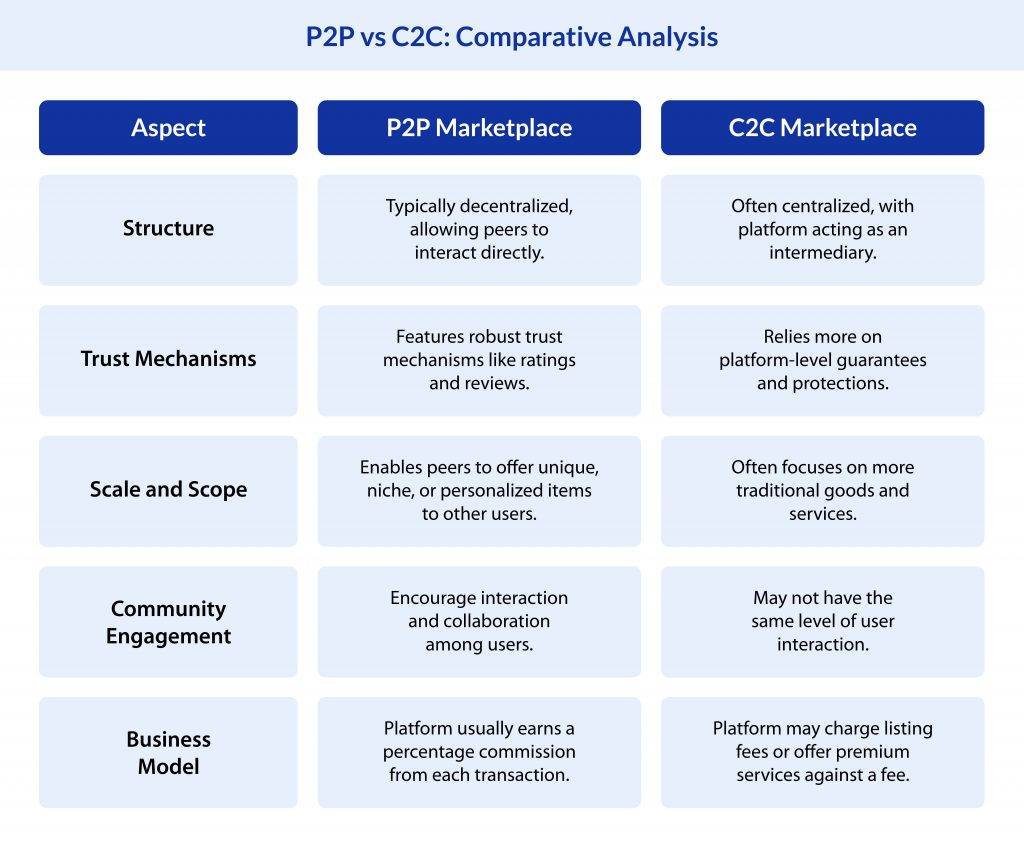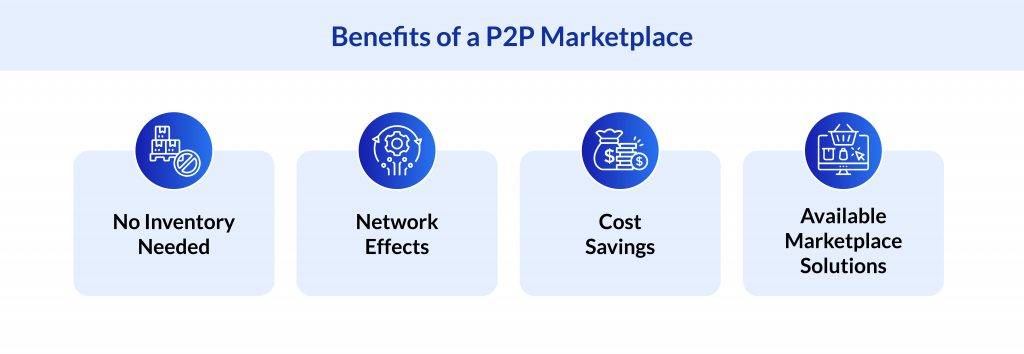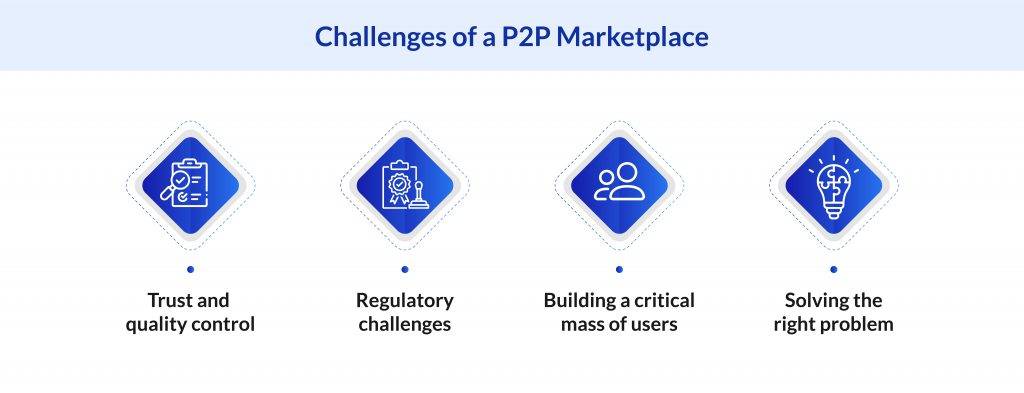The digital economy is witnessing a transformative shift with the rise of Peer-to-Peer (P2P) marketplaces. The P2P marketplace ecosystem is projected to be valued at an impressive $ 8.47 billion by 2034, with a Compound Annual Growth Rate (CAGR) of 18.7%, highlighting its significance in the modern retail industry.
As a retailer, you must understand what a peer-to-peer marketplace is and how to build a robust platform for your enterprise. This can help you establish a dynamic ecosystem where buyers and sellers connect directly, exchange value, and drive growth.
This blog offers comprehensive insights into the world of P2P online marketplaces, including their features, types, benefits, challenges, and steps for creating a successful peer-to-peer marketplace.
What Is a P2P Marketplace?
A peer-to-peer (P2P) marketplace is a dynamic platform that facilitates individuals to transact directly with each other, eliminating the need for intermediaries. It is a decentralized model that thrives on the power of community, creating a sense of trust and mutual benefit among its users.
Building a peer-to-peer marketplace involves developing a user-friendly interface, implementing secure payment systems, and providing robust customer support. This platform is meant to connect sellers and buyers in a digital environment. Whether it is renting a room, selling handicrafts, or offering freelance services, these platforms provide the necessary infrastructure to facilitate seamless transactions between both parties.
Essential Features for Peer-to-Peer Marketplaces
Here are the core features that define a successful peer-to-peer platform:
- A comprehensive user profile is the foundation of a P2P marketplace. It allows users to showcase their offerings, develop credibility, and foster a personal bond between potential buyers or sellers.
- Trust in financial transactions is essential for a successful peer-to-peer online marketplace. Implementing secure payment systems ensures that financial information is protected and users can transact with confidence.
- Feedback and ratings provided by users offer crucial perspectives on the reliability and quality of products or services. This feature encourages buyers to make informed choices and encourages openness within the platform.
Pro Tip: Leverage the Competitive Intelligence solution from Flipkart Commerce Cloud (FCC) to track your competitors’ feedback and ratings and gain valuable insights to make strategic decisions
How Is P2P Different from C2C?
While both peer-to-peer (P2P) and customer-to-customer (C2C) marketplaces facilitate transactions between individuals, they differ in several key aspects:
- Structure: A peer-to-peer marketplace platform is typically decentralized, allowing peers to interact directly. In contrast, C2C marketplaces often have a more centralized structure, with the platform acting as an intermediary.
- Trust Mechanisms: P2P platforms feature robust trust mechanisms like ratings and reviews, which are crucial for developing trust in a decentralized environment. While C2C marketplaces may also have these functionalities, they often rely more on platform-level guarantees and protections.
- Scale and Scope: P2P marketplaces cater to a wide range of products and services, enabling peers to offer unique, niche, or personalized items. C2C marketplaces, on the other hand, often focus on more traditional goods and services.
- Community Engagement: P2P marketplaces focus on community engagement with advanced features that encourage interaction and collaboration among users. C2C marketplaces, while also fostering a sense of community, may not have the same level of user interaction.
- Business Model: P2P marketplaces usually operate on a commission-based model, where the platform earns a percentage commission from each transaction. C2C marketplaces, however, may also charge listing fees or offer premium services against a fee.

H2: Types of P2P Marketplaces with Examples
Peer-to-peer marketplaces come in various forms, each catering to specific needs and industries. Here are some of the most popular categories:
Sharing Economy
This is a widely adopted model in P2P markets, and it is the sharing economy. It involves individuals renting out their assets or providing services like ride-sharing, online tutoring, home cleaning, electricians, plumbers and other handymen services. This form of peer-to-peer commerce offers an extra income stream for vendors while providing potential customers access to products and services that might not be readily available in their local area.
For businesses, a P2P marketplace presents an alternative way to enter new consumer markets without significant investment in infrastructure or product development. Consider Uber, a ride-sharing platform – an excellent example of a sharing economy. It connects drivers (service providers) with riders (service seekers), allowing them to share a ride.
Crowdfunding
Crowdfunding platforms are another popular form of peer market. These platforms enable users to initiate projects and raise funds from backers who financially support them. This type of online platform has experienced significant growth in recent years, with many startups securing the necessary funds for product development.
Crowdfunding has become an indispensable tool for entrepreneurs seeking alternative funding options beyond traditional avenues like venture capital or bank loans. Take Kickstarter, for example. It is a platform that allows creators to share their projects with a wide audience and raise funds to materialize their ideas.
Skill Sharing
In this type of peer-to-peer (P2P) marketplace solution, individuals connect based on specific skills or expertise. Whether it’s learning a new language, getting coding help, or receiving personalized fitness coaching, skill-sharing platforms offer a diverse range of learning opportunities. Users can both learn from experts and monetize their talents within this ecosystem of service marketplaces.
These platforms cater to an extensive array of skills, from technical skills like programming and software development to creative skills like writing, photography, and design. A prominent example of such a marketplace is Udemy, which allows instructors to create and share their expertise in the form of courses with learners worldwide.
Benefits of Peer-to-Peer Marketplaces
Peer-to-peer marketplaces offer a range of benefits that make them an attractive option for your retail business:
No Inventory Needed
One of the main benefits of marketplaces is that they can be established quickly and cost-effectively. In many sectors, the largest startup cost is inventory. However, for a P2P marketplace business, you do not have to bear this cost; suppliers would generate the inventory for you. Airbnb is now the world’s largest travel business, yet it does not own a single property. Instead, it operates a peer-to-peer rental model with millions of listings provided by hosts worldwide
Network Effects
Network effects can be a game-changer for peer-to-peer marketplaces, allowing them to scale much faster than traditional models. If each new user enhances the overall value of the platform, this powerful dynamic takes hold. More customers lead to more demand, attracting more suppliers. This snowball effect attracts more buyers with increased selection from a growing pool of sellers, further enhancing the user experience.
Cost Savings
As discussed above, P2P marketplaces are powered by the sharing economy, making it easier for customers to get what they want, often at a lower cost. Moreover, sellers can earn income from their products without incurring the associated costs of running a business (such as operating their platform or developing their eCommerce website). The only expenses involved are the fees levied by the enterprise operating the marketplace website.
These benefits are driving a surge in interest in the development of P2P marketplaces. Recent data indicates that the P2P marketplace ecosystem is estimated to be valued at $ 1,526.2 million in 2024 and is predicted to rise at a CAGR of 18.7% from 2024 to 2034.
Building a P2P marketplace used to be daunting. But thanks to solutions from Flipkart Commerce Cloud (FCC), it doesn’t have to be. One of FCC’s key offerings is the ability to build the entire marketplace customized to cater to your customers throughout their journey. This includes managing data hygiene and privacy, adopting retail-focused technology, and providing continuous guidance and consultation from a team with over 14 years of experience.

Challenges of a P2P Marketplace
Before you opt for a P2P marketplace model, consider the following challenges:
Trust and quality control
Trust between buyers and sellers is a significant challenge for peer-to-peer marketplaces. As a retailer, it can be tough to earn customer trust without a strong reputation or established presence in the marketplace. To establish your P2P marketplace as trustworthy and reliable, focus on offering quality products or services at competitive prices, being transparent about your practices, and providing secure payment options upfront.
Regulatory challenges
Compliance with laws pertaining to consumer protection, data privacy, and prevention of money laundering is another challenge that P2P marketplaces face. These laws can vary across countries, making transactions between customers in different geographies a complex task. As a P2P marketplace, you can consider hiring specialized legal counsel to navigate these regulatory landscapes.
Building a critical mass of users
It is important to gain a particular number of users to drive the success of your own peer-to-peer marketplace in competitive segments. You need effective strategies to attract early users and create a buzz around your P2P platform. Consider leveraging social media, influencer marketing, and referral programs to drive user acquisition and engagement. Remember, the success of your marketplace relies on the active participation of its users. So, focus on building a community around your platform, not just a customer base.
Solving the right problem
Before investing significant time and resources into your marketplace, identify a problem and build a solution for it. As a retailer, validate your idea at the initial stage by launching a Minimum Viable Product (MVP) in the marketplace as soon as possible. The feedback you receive from early adopters during the MVP stage can help determine the further enhancements required in your marketplace.

Steps to Create a Peer-to-Peer Marketplace
Here are the steps to help you create a thriving P2P marketplace that resonates with your target audience and drives sustainable growth.
- Conduct in-depth market research to classify your target audience, learn about their issues, and analyze the need for your P2P marketplace service. This crucial step ensures that you develop a website that meets users’ requirements and preferences.
- Select appropriate tools and infrastructure that can meet the particular requirements of your marketplace platform. This includes choosing a robust Content Management System (CMS), integrating secure payment gateways, and leveraging data analytics tools. It will help you acquire practical insights into user behaviour and market trends.
- To create a trustworthy platform, implement robust user authentication protocols, secure payment gateways, and comprehensive data protection measures. By prioritizing security and privacy, you demonstrate your commitment to developing a reliable environment for P2P transactions.
- Promote your marketplace and attract both buyers and sellers through a combination of incentives, discounts, and community-focused initiatives. Use targeted advertising, social media campaigns, and influencer partnerships to create buzz and drive user acquisition.
- Create a user-friendly design that streamlines navigation and elevates the overall experience for the participants. Implement communication tools, such as chat functions and discussion forums, to facilitate interactions and collaboration among users. Encourage users to share reviews and feedback, as this valuable input can help improve and refine your platform.
- Establish trust within your peer-to-peer marketplace by implementing a robust rating and review system, effective dispute resolution mechanisms, and transparent communication channels. By prioritizing trust and accountability, you create an environment where users feel confident engaging in P2P transactions.
Conclusion
Understanding the different aspects of a peer-to-peer marketplace and the considerations involved in a successful development process is crucial if you are looking to tap into this thriving business model. One solution that can streamline this process is Flipkart Commerce Cloud (FCC).
Offering a comprehensive set of e-commerce tools and infrastructure, FCC can help build your entire marketplace and customize it to cater to your customers’ needs. What sets us apart is our commitment to consultation services throughout the journey of business partnership. This means you are not just getting a technology solution but a partner that can guide you through every step of your marketplace development journey.
If you’re considering the next step in your retail journey and exploring the idea of a peer-to-peer marketplace, FCC’s experts are here to help.
Book a free demo to learn how we can help you set up your own E-commerce store.
